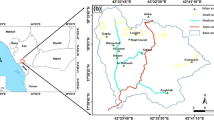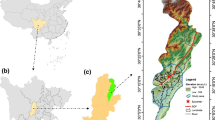Abstract
In the present study, landslide susceptibility mapping in the Goriganga valley, Kumaun Himalaya has been carried out using bivariate and multivariate approaches. Bivariate analysis includes Yule’s Coefficient, Frequency Ratio, Information Value, and Weight of Evidence, whereas multivariate analysis used is Artificial Neural Network. The input data used for this purpose include an inventory of 421 active landslides and twelve possible causative factors of landslides like lithology, slope angle, slope aspect, elevation, curvature-plan, curvature-profile, distance to drainage, road & thrusts, land use and land cover. Rainfall pattern and the peak ground acceleration (PGA) of area were also considered for the analysis. Using both the bivariate and multivariate methods, it has been observed that ~20–25% of the study area lies in the high and very high landslide susceptible zones, whereas ~50–63% of the study area lies in the low and very low susceptible zone. The high and very high landlslide susceptible zones are mainly confined in the Lesser Himalaya and along the Goriganga River, whereas low and very low susceptible zones are mainly located in the Higher Himalaya, Tethys Himalaya, and the higher elevation of the Lesser Himalaya. Further all the four bivariate methods indicate success rate between 84 and 86%, and the prediction rate between 80 and 86%, and increase with the application of the ANN.











Similar content being viewed by others
References
Abella EAC, Van Westen CJ (2008) Qualitative landslide susceptibility assessment by multicriteria analysis: a case study from San Antonio del Sur, Guantánamo. Cuba. Geomorphol 94(3–4):453–466
Agterberg FP, Bonham-Carter GF, Cheng QM, Wright DF (1993) Weights of evidence modeling and weighted logistic regression for mineral potential mapping. Comput Geol 25:13–32
Aleotti P, Chowdhury R (1999) Landslide hazard assessment: summary review and new perspectives. Bull Eng Geol Environ 58(1):21–44
Alkhasawneh MS, Ngah UKB, Tien TL, Isa NABM (2012) Landslide susceptibility hazard mapping techniques review. J Appl Sci (Faisalabad) 12(8):802–808
Ayalew L, Yamagishi H (2005) The application of GIS-based logistic regression for landslide susceptibility mapping in the Kakuda-Yahiko Mountains. Central Japan. Geomorphol 65(1–2):15–31
Bhardwaj A, Wasson RJ, Ziegler AD, Chow WT, Sundriyal YP (2019) Characteristics of rain-induced landslides in the Indian Himalaya: A case study of the Mandakini Catchment during the 2013 flood. Geomorphology 330:100–115
Bonham-Carter GF, Agterberg FP, Wright DF (1988) Integration of geological datasets for gold exploration in Nova Scotia. Photogramm Eng Remote Sens 54(11):1585–1592
Cruden DM (1991) A simple definition of a landslide. Bull Eng Geol Environ 43(1):27–29
Dahal RK, Hasegawa S, Nonomura A, Yamanaka M, Masuda T, Nishino K (2008) GIS-based weights-of-evidence modelling of rainfall-induced landslides in small catchments for landslide susceptibility mapping. Environ Geol 54(2):311–324
Devkota KC, Regmi AD, Pourghasemi HR, Yoshida K, Pradhan B, Ryu IC, Althuwaynee OF (2013) Landslide susceptibility mapping using certainty factor, index of entropy and logistic regression models in GIS and their comparison at Mugling-Narayanghat road section in Nepal Himalaya. Nat Haz 65(1):135–165
Dikshit A, Sarkar R, Pradhan B, Segoni S, Alamri AM (2020) Rainfall induced landslide studies in Indian Himalayan region: A critical review. Appl Sci 10(7):2466
Dragut L, Blaschke T (2006) Automated classification of landform elements using object-based image analysis. Geomorphology 81(3–4):330–344
Fleiss JL (1991) Statistical methods for rates and proportions. John Wiley & Sons
Fortin JG, Anctil F, Parent LE (2014) Comparison of multiple-layer perceptrons and least squares support vector machines for remote-sensed characterization of in-field lai patterns–a case study with potato. Can J Remote Sens 40(2):75–84
Greenway DR (1987) Vegetation and slope stability. Slope stability: 187-230
Gupta V, Bist KS (2004) The 23 September 2003 Varunavat Parvat landslide in Uttarkashi township, Uttaranchal. Current Science 87:1600–1605
Gupta V, Sah MP (2008) The relationship between Main Central Thrust (MCT) and the spatial distribution of mass movement in the Satluj valley, northwestern Higher Himalaya, India. Zeitschrift für Geomorphologie 52:169–179
Gupta V, Bhasin RK, Kaynia AM, Kumar V, Saini AS, Tandon RS, Pabst T (2016) Finite element analysis of failed slope by shear strength reduction technique: a case study for Surabhi Resort Landslide, Mussoorie township, Garhwal Himalaya. Geomatics, Nat Hazards and Risk 7(5):1677–1690
Gupta V, Paul A, Kumar S, Dash B (2021) Spatial distribution of landslides vis-à-vis epicentral distribution of earthquakes in the vicinity of the Main Central Thrust zone, Uttarakhand Himalaya. India Current Sci 120(12):1927–1932
Guri PK, Champati ray PK, Patel RC, (2015) Spatial prediction of landslide susceptibility in parts of Garhwal Himalaya, India, using the weight of evidence modelling. Environ Monitor Assess 187(6):324
Guri PK, Patel RC (2015) Spatial prediction of landslide susceptibility in parts of Garhwal Himalaya, India, using the weight of evidence modelling. Environ Monitor Assess 187(6):324
Guzzetti F, Carrara A, Cardinali M, Reichenbach P (1999) Landslide hazard evaluation: a review of current techniques and their application in a multi-scale study. Central Italy. Geomorphology 31(1–4):181–216
Heim A, Gansser A (1939) Central Himalaya: Geological observation of the Swiss expedition. Mem Soc Helv Sci Nat 73(1):245
Henriques C, Zezere JL, Marques F (2015) The role of the lithological setting on the landslide pattern and distribution. Eng Geol 189:17–31
Hewitt K, Gosse J, Clague JJ (2011) Rock avalanches and the pace of late Quaternary development of river valleys in the Karakoram Himalaya. GSA Bull 123(9–10):1836–1850
Huang F, Zhang J, Zhou C, Wang Y, Huang J, Zhu L (2020) A deep learning algorithm using a fully connected sparse auto encoder neural network for landslide susceptibility prediction. Landslides 17(1):217–229
Huang F, Ye Z, Jiang SH, Huang J, Chang Z, Chen J (2021) Uncertainty study of landslide susceptibility prediction considering the different attribute interval numbers of environmental factors and different data-based models. Catena 202: 105250
Kawabata D, Bandibas J (2009) Landslide susceptibility mapping using geological data, a DEM from ASTER images and an Artificial Neural Network (ANN). Geomorphology 113(1–2):97–109
Keefer DK (1984) Landslides caused by earthquakes. Geolog Soc Am Bull 95(4):406–421
Kumar V, Gupta V, Jamir I, Chattoraj SL (2019) Evaluation of potential landslide damming: Case study of Urni landslide, Kinnaur, Satluj valley. India Geosci Front 10(2):753–767
Kumar S, Gupta V, Kumar P, Sundriyal YP (2021) Coseismic landslide hazard assessment for the future scenario earthquakes in the Kumaun Himalaya, India. Bulletin of Engineering Geology and the Environment 80:5219–5235
Lee S (2019) Current and future status of GIS-based landslide susceptibility mapping: a literature review. Korean J Remote Sens 35(1):179–193
Lee S, Talib JA (2005) Probabilistic landslide susceptibility and factor effect analysis. Environ Geol 47(7):982–990
Li D, Huang F, Yan L, Cao Z, Chen J, Ye Z (2019) Landslide susceptibility prediction using particle-swarm-optimized multilayer perceptron: Comparisons with multilayer-perceptron-only, bp neural network, and information value models. Appl Sci 9(18):3664
Luo X, Lin F, Zhu S, Yu M, Zhang Z, Meng L, Peng J (2019) Mine landslide susceptibility assessment using IVM, ANN and SVM models considering the contribution of affecting factors. PLoS One 14(4): e0215134
Medsker L, Liebowitz J (1994) Design and development of expert systems and neural networks. Macmillan College Publishing Company, New York, USA
Nainwal HC, Naithani AK, Prasad C (1995) In Alaknanda Valley, Garhwal Himalaya. Bull Pure Appl Sci 14(1–2):71–92
Oh HJ, Lee S, Soedradjat GM (2010) Quantitative landslide susceptibility mapping at Pemalang area. Indonesia Environ Earth Sci 60(6):1317–1328
O’leary DW, Friedman JD, Pohn HA, (1976) Lineament, linear, lineation: some proposed new standards for old terms. Geolog Soc Am Bull 87(10):1463–1469
Ozdemir A, Altural T (2013) A comparative study of frequency ratio, weights of evidence and logistic regression methods for landslide susceptibility mapping: Sultan Mountains, SW Turkey. J Asian Earth Sci 64:180–197
Pham BT, Bui DT, Prakash I (2017) Landslide susceptibility assessment using bagging ensemble based alternating decision trees, logistic regression and J48 decision trees methods: a comparative study. Geotech Geolog Eng 35(6):2597–2611
Polat A (2021) An innovative, fast method for landslide susceptibility mapping using GIS-based LSAT toolbox. Environ Earth Sci 80(6):1–18
Ram P, Gupta V, Devi M, Vishwakarma N (2020) Landslide susceptibility mapping using bivariate statistical method for the hilly township of Mussoorie and its surrounding areas, Uttarakhand Himalaya. Journal of Earth System Science 129(1):1–18
Reichenbach P, Rossi M, Malamud BD, Mihir M, Guzzetti F (2018) A review of statistically-based landslide susceptibility models. Earth-Sci Rev 180:60–91
Sadr MP, Maghsoudi A, Saljoughi BS (2014) Landslide susceptibility mapping of Komroud sub-basin using fuzzy logic approach. Geodyn Res Int Bull 2:16–28
Sah MP, Mazari RK (1998) Anthropogenically accelerated mass movement, Kulu Valley, Himachal Pradesh. India Geomorphol 26(1–3):123–138
Sandeep Joshi A, Sah SK, Kumar P, Lal S, Devi S (2019) Modeling of 2011 IndoNepal earthquake and scenario earthquakes in the kumaon region and comparative attenuation study using PGA Distribution with the Garhwal Region. Pure and Appl Geophy 176(11):4687–4700
Saraf AK (2000) Cover: IRS-1C-PAN depicts Chamoli earthquake induced landslides in Garhwal Himalayas, India. Remote Sensing 2345-2352
Sarkar S, Roy AK, Martha TR (2013) Landslide susceptibility assessment using information value method in parts of the Darjeeling Himalayas. J Geolog Soc India 82(4):351–362
Sengupta A, Gupta S, Anbarasu K (2010) Rainfall thresholds for the initiation of landslide at Lanta Khola in north Sikkim. India Nat Haz 52(1):31–42
Sevgen E, Kocaman S, Nefeslioglu HA, Gokceoglu C (2019) A novel performance assessment approach using photogrammetric techniques for landslide susceptibility mapping with logistic regression. ANN and Random Forest Sens 19(18):3940
Shano L, Raghuvanshi TK, Meten M (2020) Landslide susceptibility evaluation and hazard zonation techniques–a review. Geoenvironmen Disasters 7:1–19
Shepherd GM and Koch C (1990) Introduction to synaptic circuits. The Synaptic Organisation of the Brain, G. M. Shepherd, ed., Oxford University Press New York 3-31
Shroder JF Jr (1998) Slope failure and denudation in the western Himalaya. Geomorphology 26(1–3):81–105
Solanki A, Gupta V, Bhakuni SS, Ram P, Joshi M (2019) Geological and geotechnical characterisation of the Khotila landslide in the Dharchula region, NE Kumaun Himalaya. J Earth Syst Sci 128(4):86
Srivastava V, Srivastava HB, Lakhera RC (2010) Fuzzy gamma based geomatic modelling for landslide hazard susceptibility in a part of Tons river valley, northwest Himalaya, India. Geomatics, Nat Haz Risk 1(3):225–242
Styczen ME, Morgan RPC (1995) Engineering properties of vegetation. In Slope stabilization and erosion control: a bioengineering approach. Taylor & Francis: 16-72
Valdiya KS (1980) Geology of kumaun lesser Himalaya. Wadia Institute of Himalayan Geology 291
Van Den Eeckhaut M, Vanwalleghem T, Poesen J, Govers G, Verstraeten G, Vandekerckhove L (2006) Prediction of landslide susceptibility using rare events logistic regression: a case-study in the Flemish Ardennes (Belgium). Geomorphology 76(3–4):392–410
Van Westen CJ (1993) Application of geographic information systems to landslide hazard zonation. Ph-D Dissertation Technical University Delft. ITC-Publication Number 15, ITC, Enschede, The Netherlands: 245
Yin KL, Yan TZ (1988) Statistical prediction model for slope instability of metamorphosed rocks. In Proceedings of the 5th International Symposium on Landslides 2: 1269-1272
Yu C, Chen J (2020) Landslide susceptibility mapping using the slope unit for southeastern helong city, jilin province, China: a comparison of ANN and SVM. Symmetry 12(6):1047
Yule GU (1912) On the methods of measuring association between two attributes. J Royal Stat Soc 75(6):579–652
Acknowledgements
The authors are thankful to the Director, Wadia Institute of Himalayan Geology (WIHG) for all the necessary support. The technical support provide by Dr PC Kumar and Dr. Parveen Kumar for the ANN and PGA analysis, respectively, is appreciated and highly acknowledged. Ms Ramandeep Kaur is also thanked for helping us to analyse the data. The study is funded by the National Mission for Sustaining the Himalayan Ecosystem (NMSHE) project “Status of Geo-resources and Impact Assessment of Geological (exogenic) Process in NW Himalayan Ecosystem” (grant no. DST/SPLICE/CCP/NMSHE/TF-3/WIHG/2015 [G]).
Author information
Authors and Affiliations
Corresponding author
Additional information
Publisher's Note
Springer Nature remains neutral with regard to jurisdictional claims in published maps and institutional affiliations.
Rights and permissions
About this article
Cite this article
Kumar, S., Gupta, V. Evaluation of spatial probability of landslides using bivariate and multivariate approaches in the Goriganga valley, Kumaun Himalaya, India. Nat Hazards 109, 2461–2488 (2021). https://doi.org/10.1007/s11069-021-04928-x
Received:
Accepted:
Published:
Issue Date:
DOI: https://doi.org/10.1007/s11069-021-04928-x




